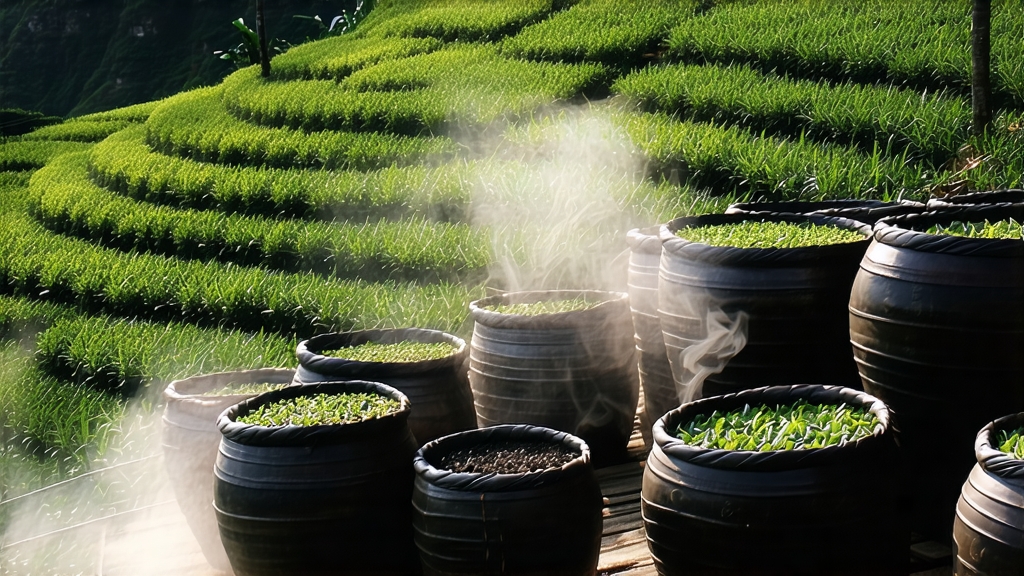
Tucked away in the southern reaches of China, where the Nanling Mountains exhale perpetual mist and the Liu River winds through dense camphor forests, lies the birthplace of Liu Bao—an often-overlooked dark tea whose mellow, medicinal liquor once greased the gears of the ancient Tea-Horse Road. While Pu-erh has become the global shorthand for fermented tea, Liu Bao remains a quiet guardian of the same microbial magic, offering a gentler, more candied pathway into the world of post-fermentation. To understand Liu Bao is to listen to a 1,500-year dialogue between Han tea masters, Yao herb-gatherers, and the invisible guild of yeasts and molds that still govern the bamboo-lined storerooms of Wuzhou.
Historical whispers first place Liu Bao in the Tang dynasty (618-907 CE), when mountain villagers compressed rough tea into bamboo tubes for porters carrying salt and silk toward the Chamavaca Pass. By the Qing era, the tea had graduated to woven rattan baskets, earning the name “Liu Bao” after the six (liu) original forts (bao) that protected the trade route. Junks sailed the tea down the Xi River to Guangzhou, where foreign clipper ships exchanged it for silver and opium; thus Liu Bao entered European apothecaries labeled “China Dark Tea” and was prescribed for dysentery aboard East India Company vessels. The Republican period saw the construction of the first commercial wet-piling workshops, mirroring the techniques that would later define ripe Pu-erh, yet Liu Bao kept its lower, slower ferment and its signature betel-nut fragrance.
Today the micro-appellations within Cangwu County—Shanping, Yingdi, Heishi—are to Liu Bao what Margaux is to Bordeaux. Leaves harvested from the indigenous Zhongye (middle-leaf) cultivar, a close cousin of the Yunnan Da Ye, are picked in late April when three leaves and a bud still wear the spring chill. The first critical choice is the firing temperature: 280 °C for ninety seconds arrests oxidation but preserves leaf enzymes that will later cooperate with Eurotium cristatum, the celebrated “golden flower” mold. After a brief rest, leaves are rolled under linen-covered boards until the cell rupture rate reaches 65 %, high enough to release sticky catechins yet low enough to keep the strip intact for basket weaving.
The hallmark of Liu Bao is its unique “wet piling” or sao dui, a milder cousin of Yunnan’s wo dui. Leaves are sprayed with mineral-rich mountain water, stacked 70 cm high under jute tarpaulins, and left to ferment for 25–35 days—half the duration of ripe Pu-erh. Every four days a team of “tea foot doctors” turn the pile, inserting bamboo thermometers to keep the core below 55 °C, a temperature sweet spot that encourages lactobacillus while discouraging harmful bacillus subtilis. When the leaf spine snaps with a clean click and exudes the aroma of dried longan, the pile is dismantled and sun-dried on raised bamboo racks. A final charcoal roasting in dragon-eye wood kilns fixes the moisture at 10 % and gifts a whisper of smoked lychee that will later bloom in the cup.
Unlike Pu-erh’s stone-pressing, Liu Bao is traditionally packed into 40 kg rattan baskets lined with wild banana leaf. The gentle pressure allows continued micro-aeration; over decades the tea “breathes” through the porous weave, trading tannins for mahogany smoothness. Connoisseurs speak of three inflection points: the “bamboo green” phase (1–5 years) when youthful astringency still recalls fresh sugarcane; the “red date” plateau (6–15 years) where Eurotium spores freckle the leaves with golden stars and the liquor turns osmanthus amber; and the “ginseng” epoch (20+ years) that delivers a dark, mirror-like broth reminiscent of Korean red ginseng and Chinese patent medicine.
To brew Liu Bao is to court a quiet ritual. Begin by awakening the leaves with a 95 °C rinse, pouring the first infusion onto a yixing clay “tea pet” to honor the spirit of the mountain. For gongfu service, use 6 g of leaf in a 120 ml zisha pot; flash infusions of 10, 8, 12, 16, 20 seconds coax out a staircase of flavors—betel